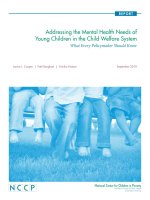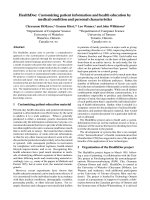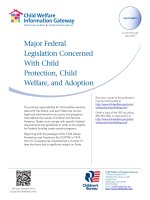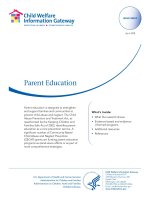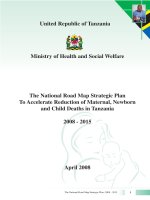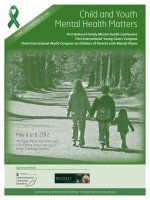CHILD WELFARE INFORMATION GATEWAY: PARENT EDUCATION potx
Bạn đang xem bản rút gọn của tài liệu. Xem và tải ngay bản đầy đủ của tài liệu tại đây (119.66 KB, 9 trang )
ISSUE BRIEF
Parent Education
Parent education is designed to strengthen
and support families and communities to
prevent child abuse and neglect. The Child
Abuse Prevention and Treatment Act, as
reauthorized by the Keeping Children and
Families Safe Act of 2003, identifi es parent
education as a core prevention service. A
significant number of Community-Based
Child Abuse and Neglect Prevention
(CBCAP) grants are funding parent education
programs as stand-alone efforts or as part of
more comprehensive strategies.
April 2008
What’s Inside:
• What the research shows
• Evidence-based and evidence-
informed programs
• Additional resources
• References
Child Welfare Information Gateway
Children’s Bureau/ACYF
1250 Maryland Avenue, SW
Eighth Floor
U.S. Department of Health and Human Services
Administration for Children and Families
Washington, DC 20024
Administration on Children, Youth and Families
703.385.7565 or 800.394.3366
Email:
Children’s Bureau
www.childwelfare.gov
Parent Education
www.childwelfare.gov
Successful parent education programs help
parents acquire and internalize parenting
and problem-solving skills necessary to
build a healthy family. Research has shown
that effective parent training and family
interventions promote protective factors
and lead to positive outcomes for both
parents and children (Lundahl & Harris,
2006). Protective factors include nurturing
and attachment, knowledge of parenting
and of child and youth development,
parental resilience, social connections, and
concrete supports for parents (Child Welfare
Information Gateway, U.S. Department
of Health and Human Services Children’s
Bureau, & FRIENDS National Resource
Center For Community-Based Child Abuse
Prevention, 2008).
This issue brief provides an overview of
research regarding some key characteristics
and training strategies of successful parent
education programs. Information about
selected evidence-based and evidence-
informed parent education programs,
including a list of registries that cite the
program, also is provided.
What the Research Shows
Program characteristics and specifi c training
strategies are both key considerations when
selecting a parent education program.
Program characteristics refer to broader
aspects of a program, such as theoretical
grounding or how the program is structured,
staffed, and evaluated. Training strategies
refer to specific teaching methods that have
been found to be effective in working directly
with parents.
Key Program Characteristics
The following characteristics have been
found to be strong predictors of program
effectiveness:
Strength-based focus. A large body of
research supports the emphasis on family
interventions and education programs that
focus on family strengths and resilience
instead of family weaknesses. This approach
reinforces existing protective factors to
prevent the occurrence or reoccurrence
of child abuse and neglect (Center for the
Study of Social Policy, 2003).
Family-centered practice. Family-centered
parent training programs include family
skills training and family activities to
help children and parents communicate
effectively and take advantage of concrete
social supports. Family-centered programs
also seek to develop training strategies
that are culturally appropriate and
consistent with the beliefs and principles
of families and their communities (Colosi &
Dunifon, 2003).
Individual and group approaches.
Evidence suggests that a combination of
individual and group parent training is the
most effective approach when building
skills that emphasize social connections and
parents’ ability to access social supports.
However, the individual approach was
found to be more effective when serving
families in need of specific or tailored
services (Lundahl, Nimer, & Parsons, 2006).
Qualifi ed staff. Program success is in large
part dependent on qualified staff. Program
staff should have a sound theoretical
grounding as well as hands-on experience
in the classroom or working with families
This material may be freely reproduced and distributed. However, when doing so, please credit Child Welfare
Information Gateway. Available online at www.childwelfare.gov/pubs/issue_briefs/parented/
2
Parent Education
www.childwelfare.gov
and groups in different settings. Staff
also should be able to provide culturally
competent services consistent with the
values of the family and the community.
Targeted service groups. Learning is
enhanced when the participants of each
program include a clearly defined group of
people with common needs or identifying
characteristics (Colosi & Dunifon, 2003).
Group characteristics, such as high risk
families or working versus nonworking
parents, also can help determine the
appropriate program duration and intensity
(Brown, 2005).
Clear program goals and continuous
evaluation. Successful programs maintain
individualized and group plans developed
in partnership with participants. Progress
toward program goals is routinely and
effectively evaluated by aggregate
analyses using both quantitative and
qualitative research methods consistent
with the services offered. In addition,
these programs have an effective process
for gathering consumer feedback and
use this information, along with outcome-
based evaluation efforts, for continuous
quality improvement.
Parent Training Strategies
The following parent training strategies may
be employed in a variety of service settings
and with multiple target populations. These
strategies reinforce protective factors and can
be adapted as appropriate to fit program and
participant needs.
Encourage peer support. Programs
that offer opportunities for parental peer
support have a positive impact on children’s
cognitive outcomes. Peer support also
strengthens family bonds and gives parents
an opportunity to share their experiences
in constructive settings (Layzer, Goodson,
Bernstein, & Price, 2001).
Involve fathers. Research indicates that
father involvement in parent training leads
to better outcomes and promotes family
cooperation and cohesion. Excluding
fathers from parent training programs
decreases the likelihood of success
(Lundahl, Tollefson, Risser, & Lovejoy, 2007).
Promote positive family interaction.
Promoting family relationships is a key
component of parent education programs
and involves strategies to improve family
interaction, communication, and parental
supervision. Increasing positive parent-
child interactions has been found to be
associated with larger effects on measures
of enhanced parenting behaviors (Kaminski,
Valle, Filene, & Boyle, 2008). Strengthening
marriages also plays a part in achieving
positive family interaction (Brown, 2005).
Use interactive training techniques.
Interactive methods, as opposed to didactic
lecturing, are a key aspect of successful
parent education programs and include
activities such as group discussion, role
playing, active modeling, homework
exercises, and reviewing videos of effective
parenting approaches (Brown, 2005).
Provide opportunities to practice new
skills. Requiring parents to practice
new skills with their children during
parent training sessions is consistently
associated with greater effectiveness of
parent education programs. Specifi c skills
associated with larger effects on parent
and child behavior include emotional
communication skills, the use of time-out,
This material may be freely reproduced and distributed. However, when doing so, please credit Child Welfare
Information Gateway. Available online at www.childwelfare.gov/pubs/issue_briefs/parented/
3
Parent Education
www.childwelfare.gov
and parenting consistency. These were
found to be more effective than other
common strategies, such as teaching
parents problem-solving skills or ways to
promote children’s cognitive, academic, or
social skills (Kaminski et al., 2008; Lundahl
& Harris, 2006).
Evidence-Based and Evidence-
Informed Programs
This section lists selected parent education
curricula that have been included on various
registries of evidence-based and evidence-
informed programs. Each focuses on specifi c
risk and protective factors. Curriculum
availability will vary, and some programs
require specific training for group facilitators.
The following list is by no means all-inclusive.
It does not constitute an endorsement of
any particular program and is provided only
as a descriptive tool. For more information
about these programs and the criteria used
to evaluate them, visit the program website
or the registries listed in the Additional
Resources section of this paper.
Guiding Good Choices®
Program objectives: Give parents the skills
they need to help reduce their children’s
risk for using alcohol and other drugs
by enhancing family management and
communication skills.
Target population: Parents of children ages
9-14.
Delivery setting and format: Conducted
at convenient locations once per week;
take-home self-study program or family
workshops available.
Duration: Five 2-hour workshops.
Training resources: Workshop guide,
video, family guide, and visual aids.
Phone: 800.477.4776
Website: www.channing-bete.com/
prevention-programs/guiding-good-
choices/
Registries that cite this program:
California Evidence-Based Clearinghouse
for Child Welfare
Helping America’s Youth
Office of Juvenile Justice and Delinquency
Prevention
Promising Practices Network
The Incredible Years©
Program objectives: Strengthen
parenting competencies (monitoring,
positive discipline, confi dence) and
support parents’ involvement in children’s
school experiences in order to promote
children’s academic, social, and emotional
competencies and reduce conduct
problems.
Target population: Parents, teachers, and
children ages 3-12 (individual curricula may
be used separately or in combination).
Delivery setting and format: Conducted
in a community agency, outpatient clinic, or
school in groups of 12-16 parents or groups
of 6 children.
This material may be freely reproduced and distributed. However, when doing so, please credit Child Welfare
Information Gateway. Available online at www.childwelfare.gov/pubs/issue_briefs/parented/
4
Parent Education
www.childwelfare.gov
Duration: The Basic Parent Training
program is 12-14 weeks. The Child Training
Program is 18-22 weeks. The Advanced
Parent Program is a supplemental program.
Basic training plus Advanced training takes
18-22 weeks.
Training resources: Program manual and
staff training available.
Phone: 888.506.3562
Website: www.incredibleyears.com
Registries that cite this program:
California Evidence-Based Clearinghouse
for Child Welfare
Child Trends
Helping America’s Youth
Office of Juvenile Justice and Delinquency
Prevention
Promising Practices Network
Strengthening America’s Families
Nurturing Parenting Programs®
Program objectives: Build nurturing
parenting skills as an alternative to abusive
and neglectful parenting and child-rearing
practices, in order to prevent recidivism in
families receiving social services, lower the
rate of teenage pregnancies, reduce the
rate of juvenile delinquency and alcohol
abuse, and stop the intergenerational cycle
of child abuse.
Target population: Parents with children
birth to 5 years old, 5-11 years old, and
12-18 years old. Programs for school-age
children 5-11 years old and teens 12-18
years old also are offered.
Delivery setting and format: Conducted
in birth family homes, community agencies,
departments of mental health, departments
of social services, parent education
programs, prisons, residential care facilities,
and schools, in groups of 8-12 adults.
Children meet in a separate group.
Duration: 12-48 weeks.
Training resources: Training manual
available.
Phone: 828.698.7609
Website: www.nurturingparenting.com
Registries that cite this program:
California Evidence-Based Clearinghouse
for Child Welfare
Center for the Improvement of Child Caring
Helping America’s Youth
Strengthening America’s Families
Parent-Child Interaction Therapy (PCIT)
Program objectives: Strengthen the
parent-child bond, decrease harsh and
ineffective discipline-control tactics,
improve child social skills and cooperation,
and reduce child negative or maladaptive
behaviors.
Target population: Children ages 3-6 with
parent-child relationship and behavior
problems. May be conducted with parents,
foster parents, or other caretakers. Program
adaptation available for physically abusive
parents with children ages 4-12.
Delivery setting and format: Conducted in
a community agency or outpatient clinic in
groups of 3 or 4 families during a 90-minute
This material may be freely reproduced and distributed. However, when doing so, please credit Child Welfare
Information Gateway. Available online at www.childwelfare.gov/pubs/issue_briefs/parented/
5
Parent Education
www.childwelfare.gov
session. Allows time for individual coaching
of each parent-child group while the other
groups observe and provide feedback.
Duration: Average number of sessions is
14, but varies from 10-20 sessions.
Training resources: 40 hours of direct
training, with ongoing supervision and
consultation for approximately 4-6 months;
a manual is used during sessions with
families.
Phone: 352.273.5239
Website: www.pcit.org
Registries that cite this program:
California Evidence-Based Clearinghouse
for Child Welfare
Child Trends
National Child Traumatic Stress Network
SafeCare
Program objectives: Provide direct skill
training to parents in child behavior
management, activity planning, home
safety, and child health care to prevent child
maltreatment.
Target population: Parents with a history or
risk of child neglect or abuse.
Delivery setting and format: Conducted
in family homes, once per week for
approximately 1.5 hours per session.
Duration: 18-20 weeks.
Training resources: Training manual
available.
Phone: 404.419.4457
Website: www.marcus.org/treatment/
safecare.html
Registries that cite this program:
California Evidence-Based Clearinghouse
for Child Welfare
Staying Connected With Your Teen®
Program objectives: Encourage parents
and teens to work together to enhance
communication and family management
practices and decrease confl ict.
Target population: For parents of teens
ages 12-16.
Delivery setting and format: Conducted
at convenient locations once per week;
take-home self-study program or family
workshops available.
Duration: 5 weeks.
Training resources: Workshop guide,
video, family guide, PowerPoint
presentation, and CD; telephone advisor if
necessary.
Phone: 800.477.4776
Website: www.channing-bete.com/
prevention-programs/staying-connected-w-
your-teen/
Registries that cite this program:
Center for the Application of Substance
Abuse Technologies
STEP (Systematic Training for Effective
Parenting)
Program objectives: Help parents learn
effective ways to relate to their children,
This material may be freely reproduced and distributed. However, when doing so, please credit Child Welfare
Information Gateway. Available online at www.childwelfare.gov/pubs/issue_briefs/parented/
6
Parent Education
www.childwelfare.gov
how to encourage cooperative behavior
in their children, and how not to reinforce
unacceptable behaviors. STEP also
helps parents change dysfunctional and
destructive relationships with their children
by offering concrete alternatives to abusive
and ineffective methods of discipline and
control.
Target population: Parents of children ages
0-6 and parents of teenagers.
Delivery setting and format: Conducted
in adoptive homes, birth family homes,
community agencies, foster homes,
hospitals, outpatient clinics, residential care
facilities, and schools in small discussion
groups to promote better interaction.
Duration: 7 weeks.
Training resources: Training and program
manuals available.
Phone: 800.328.2560
Website: www.parentingeducation.com
Registries that cite this program:
California Evidence-Based Clearinghouse
for Child Welfare
Center for the Improvement of Child Caring
Triple P-Positive Parenting Program
Program objectives: Prevent severe
behavioral, emotional, and developmental
problems in children by enhancing the
knowledge, skills, and confi dence of
parents.
Target population: Parents and caregivers
of children from birth through age 16.
Delivery setting and format: Conducted
in adoptive homes, birth family homes,
community agencies, foster homes,
hospitals, outpatient clinics, residential care
facilities, and schools in groups of 10-12
parents of children and adolescents from
birth to age 16.
Duration: Varies depending on the type of
intervention required.
Training resources: Training manual
available.
Phone: 803.787.9944
Website: www.TripleP-America.com
Registries that cite this program:
California Evidence-Based Clearinghouse
for Child Welfare
Child Trends
1-2-3 Magic
Program objectives: Help parents learn
effective methods of controlling negative
behavior, encouraging good behavior, and
strengthening the child-parent relationship.
The program seeks to encourage gentle
but firm discipline without arguing, yelling,
or spanking.
Target population: Parents, grandparents,
teachers, babysitters, and caretakers
working with children.
Delivery setting and format: Conducted
in adoptive homes, birth family homes,
community agencies, foster homes,
hospitals, outpatient clinics, residential care
facilities, and schools in groups of 6-25
parents of children approximately 2-12
years of age.
This material may be freely reproduced and distributed. However, when doing so, please credit Child Welfare
Information Gateway. Available online at www.childwelfare.gov/pubs/issue_briefs/parented/
7
Parent Education
www.childwelfare.gov
Duration: 1.5 hours per session for 4-8
weeks.
Training resources: Training manual
available.
Phone: 630.790.9600
Website: www.parentmagic.com
Registries that cite this program:
California Evidence-Based Clearinghouse
for Child Welfare
Additional Resources
The following resources include additional
research and information on model parent
education programs and curricula.
The California Evidence-Based
Clearinghouse for Child Welfare is designed
to serve as an online connection for child
welfare professionals, staff of public and
private organizations, academic institutions,
and others. It provides up-to-date information
on evidence-informed child welfare practices,
including parent training programs.
www.cachildwelfareclearinghouse.org/search/
topical-area/1
The Center for the Application of Substance
Abuse Technologies works to improve
substance abuse prevention and treatment
services by helping States, organizations,
agencies, and individuals apply evidence-
based practices.
www.casat.unr.edu/
The Center for the Improvement of Child
Caring is a national organization that provides
information on parenting, parent education
resources, skills-building seminars, training for
professionals, and more.
www.ciccparenting.org/
Child Trends is an independent, nonpartisan
research center focused exclusively on
children that provides information on ground-
breaking research, policy insights, program
guidance, and emerging trends and issues.
www.childtrends.org
Helping America’s Youth is a nationwide
effort to raise awareness about the challenges
facing our youth, particularly at-risk boys,
and to motivate caring adults to connect
with youth in three key areas: Family, school,
and community.
www.helpingamericasyouth.gov/index.cfm
The National Child Traumatic Stress
Network works to raise the standards of care
and improve access to services for traumatized
children, their families, and communities
throughout the United States.
www.nctsnet.org/nccts/nav.do?pid=hom_main
The Offi ce of Juvenile Justice and
Delinquency Prevention’s Model Programs
Guide is designed to assist practitioners and
communities in implementing evidence-
informed and evidence-based prevention
and intervention programs that can make
a difference in the lives of children and
communities.
www.dsgonline.com/mpg2.5/mpg_index.htm
Promising Practices Network features
descriptions of evaluated programs that
improve outcomes for children.
www.promisingpractices.net/programs_alpha.
asp
Strengthening America’s Families provides
the results of a 1999 search for “best
practice” family strengthening programs.
This material may be freely reproduced and distributed. However, when doing so, please credit Child Welfare
Information Gateway. Available online at www.childwelfare.gov/pubs/issue_briefs/parented/
8
Parent Education
www.childwelfare.gov
www.strengtheningfamilies.org/html/model_
programs.html
The USDA Parent Education and Support
Literature Review is made possible through
funding by the U.S. Department of Agriculture
Cooperative State Research, Education, and
Extension Services. The most recent review
was conducted in 2005.
professionalresources/parentEd/2005litreview.
htm
References
Brown, M. (2005). USDA parent education
and support literature review. University of
Delaware Cooperative Extension. Retrieved
February 11, 2008, from: l.
edu/extension/fam/professionalresources/
parentEd/2005litreview.htm
Center for the Study of Social Policy. (2003).
Protective factors literature review: Early
care and education programs and the
prevention of child abuse and neglect.
Retrieved February 11, 2008, from: www.
cssp.org/uploadFiles/horton.pdf
Child Welfare Information Gateway, U.S.
Department of Health and Human Services
Children’s Bureau, & FRIENDS National
Resource Center For Community-Based
Child Abuse Prevention. (2008). Promoting
healthy families in your community: 2008
resource packet. Retrieved February 20,
2008, from: www.childwelfare.gov/pubs/
res%5Fpacket%5F2008/
Colosi, L. & Dunifon, R. (2003). Effective
parent education programs. Cornell
University College of Human Ecology:
Parenting In Context. Retrieved February
11, 2008, from: www.parenting.cit.cornell.
edu/Effective%20Parent%20Education%20
Programs.pdf
Kaminski, J. W., Valle, L. A., Filene, J. H., &
Boyle, C. L. (2008). A meta-analytic review
of components associated with parent
training program effectiveness. Journal of
Abnormal Child Psychology, 36(4), 567–589.
Layzer, J. I., Goodson, B. D., Bernstein, L.,
& Price, C. (2001). National evaluation
of family support programs volume A:
The meta-analysis. Cambridge, MA: Abt
Associates, Inc. Retrieved February 11,
2008, from: www.acf.hhs.gov/programs/
opre/abuse_neglect/fam_sup/reports/
famsup/fam_sup_vol_a.pdf
Lundahl, B. W., Tollefson, D., Risser, H., &
Lovejoy, M. C. (2007). A meta-analysis
of father involvement in parent training.
Research on Social Work Practice, 18, 1-10.
Lundahl, B. W., Nimer, J., & Parsons, B. (2006).
Preventing child abuse: A meta-analysis
of parent training programs. Research on
Social Work Practice, 16, 251-62.
Lundahl, B. W., & Harris, N. (2006). Delivering
parent training to families at risk to
abuse: Lessons from three meta-analyses.
Columbus, OH: American Professional
Society on the Abuse of Children.
This issue brief was developed in partnership
with the FRIENDS National Resource Center
for Community-Based Child Abuse Prevention.
This material may be freely reproduced and distributed. However, when doing so, please credit Child Welfare
Information Gateway. Available online at www.childwelfare.gov/pubs/issue_briefs/parented/
9
